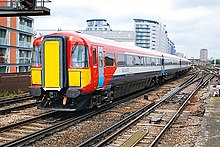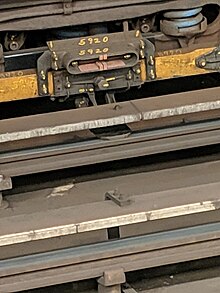
Back السكة الثالثة Arabic Kontakt relsi Azerbaijani তৃতীয় রেল Bengali/Bangla Tercer carril Catalan Napájecí kolejnice Czech Strømskinne Danish Stromschiene German Kontaktrelo Esperanto Tercer riel (alimentación) Spanish Toiterööbas Estonian
This article needs additional citations for verification. (June 2021) |


A third rail, also known as a live rail, electric rail or conductor rail, is a method of providing electric power to a railway locomotive or train, through a semi-continuous rigid conductor placed alongside or between the rails of a railway track. It is used typically in a mass transit or rapid transit system, which has alignments in its own corridors, fully or almost fully segregated from the outside environment. Third-rail systems are usually supplied from direct current electricity.
Modern tram systems with street-running, avoid the risk of electrocution by the exposed electric rail by implementing a segmented ground-level power supply, where each segment is electrified only while covered by a vehicle which is using its power.[1]
The third-rail system of electrification is not related to the third rail used in dual-gauge railways.
- ^ Christeller, Reinhard (17 June 2020). "Innovative power supply technologies for traction systems in public transport". Urban Transport. Retrieved 8 February 2022.
© MMXXIII Rich X Search. We shall prevail. All rights reserved. Rich X Search